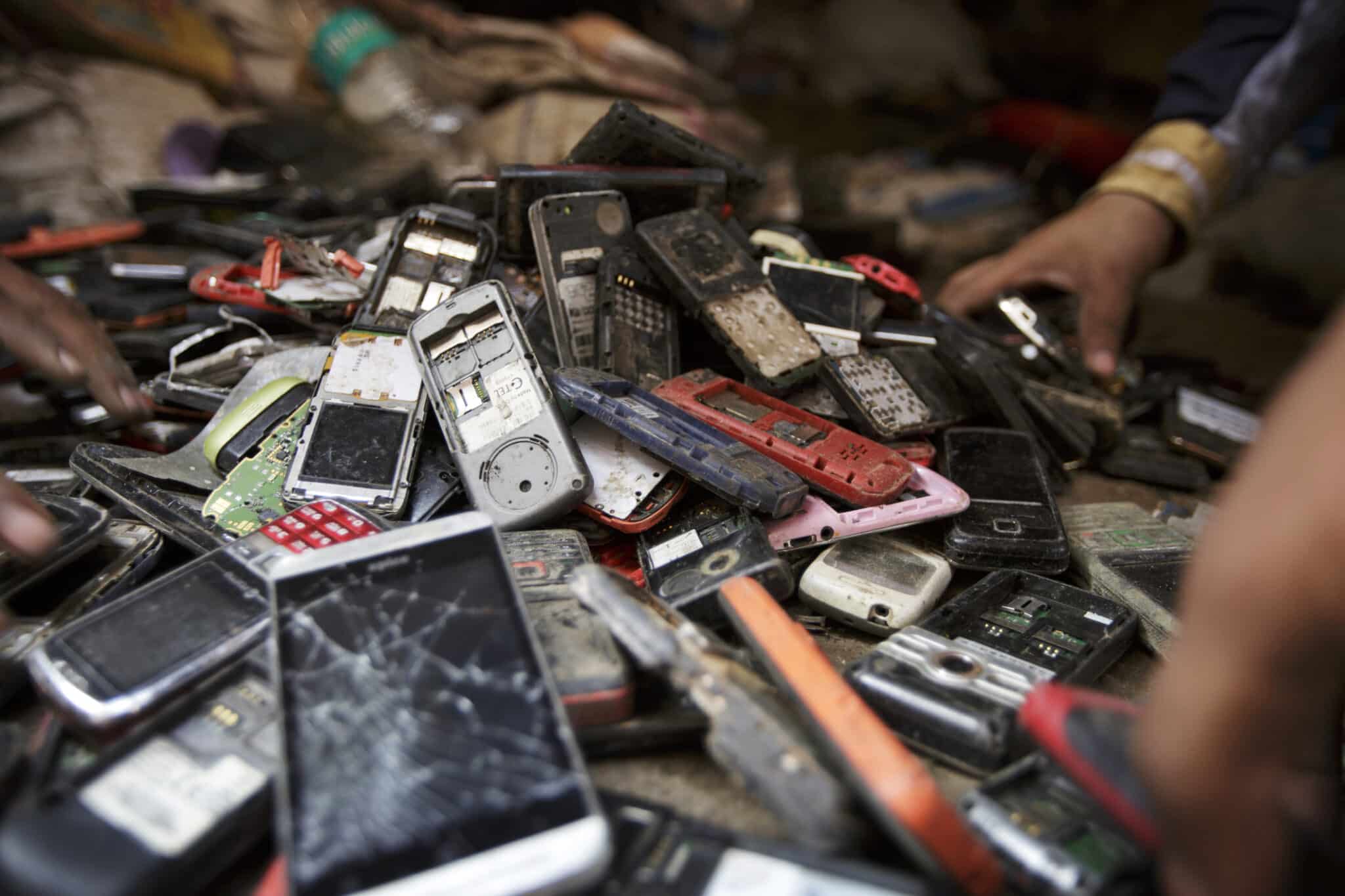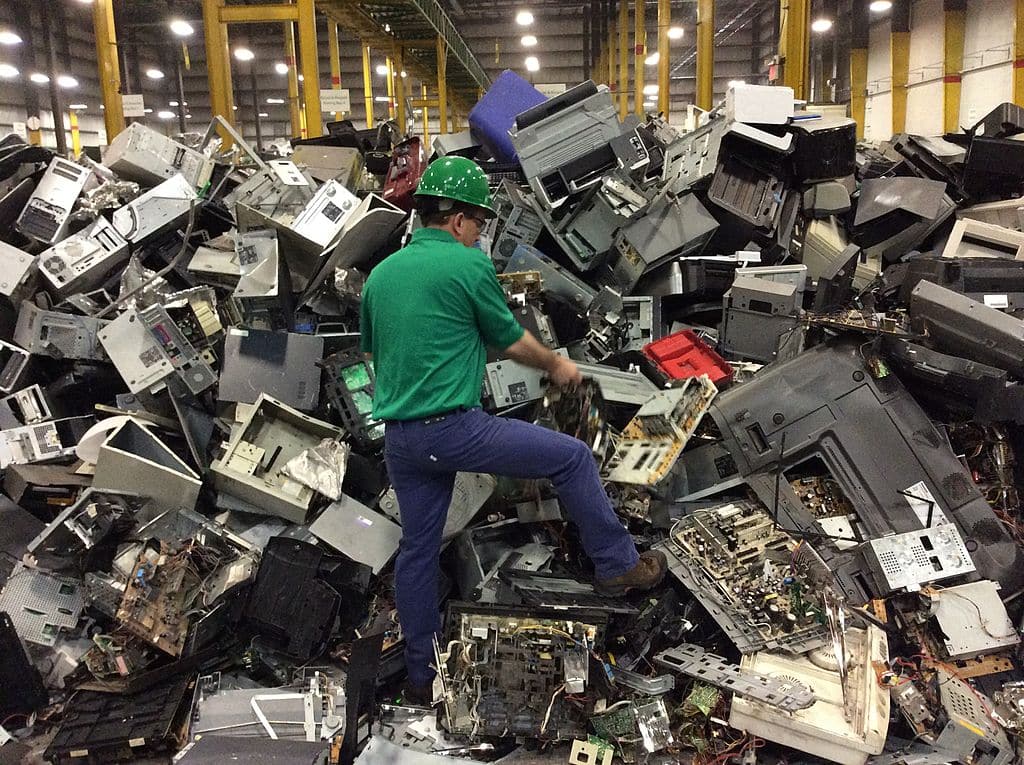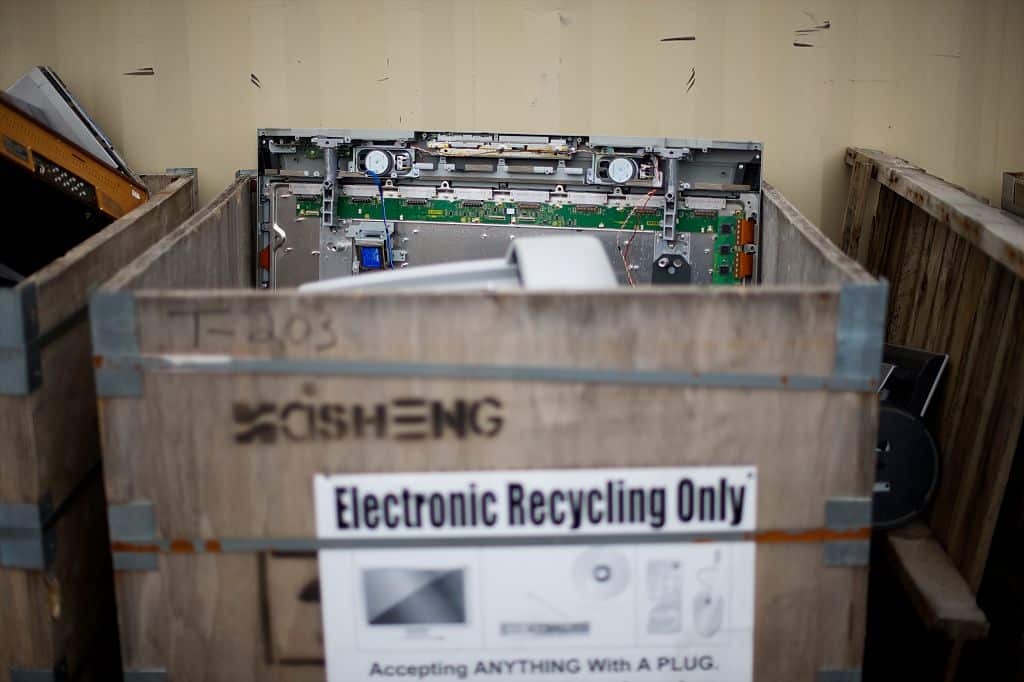E-Waste 101: Everything You Need to Know

 Why you can trust us
Why you can trust us
Founded in 2005 as an Ohio-based environmental newspaper, EcoWatch is a digital platform dedicated to publishing quality, science-based content on environmental issues, causes, and solutions.
Quick Key Facts
- E-waste is the fastest-growing waste stream in the world; between 50 and 60 million tons are produced every year.
- The e-waste discarded in 2021 alone weighs more than the Great Wall of China: the heaviest man-made structure in the world.
- 75-80% of e-waste is shipped to countries in Africa and Asia, where poor and marginalized communities suffer health and environmental consequences.
- Electronics contain hazardous materials like lead, mercury, and cadmium, which leach into the surrounding environment when placed in landfills, or when the products are burned by “backyard recyclers” in Global South trying to extract valuable materials like gold and copper.
- Less than 20% of e-waste generated each year is properly recycled.
- E-waste contains valuable materials that can be extracted through proper recycling. It’s estimated that unrecycled e-waste contains $57 billion worth of recoverable precious metals.
- Only 25 US states and Washington, D.C. have some kind of e-waste legislation, either mandating the recycling of e-waste, banning disposal in landfills, or prohibiting export to other countries.
What is E-Waste?
E-waste – also called electronic waste, e-scrap, end-of-life electronics, or WEEE (Waste Electrical and Electronic Equipment) – is electronics that have been discarded, donated, or recycled. The term “waste,” however, is somewhat misleading; many items still have value in that they can be repurposed or recycled to extract desirable materials inside them.
Six waste categories are included under the umbrella term of “e-waste:” Temperature exchange equipment (like heating/cooling devices), screens and monitors, lamps, large equipment (like washing machines, dishwashers, copying and printing machines, etc.), small equipment (vacuum cleaners, microwaves, electronic toys and tools, radios), and small IT and telecommunication equipment (cell phones, GPSs, personal computers).
Unlike most general municipal waste, e-waste is extremely hazardous and contains toxic materials like beryllium, cadmium, mercury, and lead, so recycling these products requires intensive sorting and handling. E-waste – in part due to the complex requirements for disposal – is often exported to countries in the Global South, where it poses health and safety hazards for local people who mine valuable materials from end-of-life electronics.
Generation of E-Waste
E-waste is a growing waste stream: the fastest-growing in the world, according to Green Alliance, increasing by 21% between 2014 and 2019. Between 50 and 60 million tons are generated each year, which amounts to about 2-3% of annual global waste. While it might seem like an inconsequential percentage, the consequences of runaway e-waste production are extreme.
Why is There so Much?
When the iPhone was released in 2007, 1.4 million units were sold that year. Now, the same amount of phones are sold every 2.5 days. This growth is representative of our greater dependence upon electronics in all facets of the economy and daily life, from which our mounting e-waste stream arises. It’s estimated that 63.3 million US tons of electronic waste were discarded in 2021 – that’s heavier than the Great Wall of China, the heaviest human construction in the world – and it’s only expected to grow. In 2030, e-waste is projected to hit 81.6 million US tons: an amount that could fill more than 100 Empire State buildings.
Planned Obsolescence
Does it ever feel like new, updated cell phones and computers are coming out much faster than they used to? Not only is this true, but it’s a tactic intentionally employed by technology companies so that older models become outdated faster and faster. Even if a product works perfectly well, sometimes just the perception of it as “old” will drive replacement (called “perceived obsolescence”). On average, a person now only keeps a cell phone for about two to three years. Each new product release also comes with new chargers, adapters, and compatible products, making their older counterparts unusable and trash-bound.
But, some manufacturers will also deliberately design products to last for only a certain amount of time: a phenomenon known as “planned obsolescence.” Sometimes, the cost of repairing a failing phone or computer is actually more expensive than buying a new product: another intentional tactic to drive up purchasing. Oftentimes, new software updates are incompatible with older models, and as the world is upgrading to 5G, entire generations of cell phones will soon become obsolete.
E-Waste Recycling

Because of the many toxic chemicals present in e-waste, discarded electronics must go through a complicated recycling process that involves separating their plastics, metals, and internal circuitry. E-waste recycling provides an alternative to throwing waste in landfills, where it leaches and causes a hazard to both human and environmental health. Recycling services are provided by some local and state governments – or federally, in some countries outside of the US – or by private recycling businesses.
Benefits of Recycling E-Waste
Along with hazardous toxins, e-waste also contains valuable materials that could be reused in future products. According to the EPA, recycling one million cell phones recovers over 35,000 pounds of copper, 772 pounds of silver, 75 pounds of gold, and 33 pounds of palladium. Extracting these materials has economic benefits; a 2018 study found that mining aluminum, copper, and gold is 13 times more expensive than collecting it from properly-recycled electronics
Lithium, for one, is used in many industries and is crucial for making the batteries of electric cars. Because of the huge demand for these vehicles paired with the slow extraction of the element, lithium is in short supply. Mining it from recycled e-waste will supply more to the market, keeping the price of electric cars from skyrocketing due to scarcity.
How is it Done?
The e-waste recycling process entails many steps in order to separate valuable materials from non-valuable and hazardous ones. First, the waste is sorted manually into different types and models and examined to see what can be reused either as parts or to form new products. What is left goes through a demanufacturing process whereby products are disassembled and hazardous material is removed. Photocopying machines, for example, contain toner that is very flammable and could cause explosions in later stages of the recycling process. The remaining non-hazardous waste is shredded in a machine, and from the shreds, valuable materials are removed; a giant magnet captures ferromagnetic materials like iron and steel. This process of finding and removing metals and other desirable materials is what makes the recycling industry profitable. Lastly, water is used to separate the remaining materials (plastic will float, while heavier items will fall).
Why is Recycling E-Waste so Complicated?
In 2019, only 17.4% of global e-waste generated was collected and properly recycled, due in part to the complexity of the process. Each of the six e-waste categories is different – different amounts are generated, they have different economic values, and they pose different threats to human health and the environment – so, the way they must be collected and recycled is very different and requires varied technology. Many products also aren’t designed to be easily recycled, like our ever-slimmer smartphones that resist removal of their batteries. Recycling machines must constantly be upgraded to keep up with changing technology, and manual sorting exposes workers to low levels of chemicals over a long period of time. Regardless, 10/60 elements in most e-waste can’t be recycled through mechanical processes, including aluminum, cobalt, copper, gold, iron, lead, platinum, silver, and tin.
Lack of Regulation
Lack of proper regulation surrounding e-waste in the US also makes disposal more complicated. While other countries have more stringent laws around e-waste, only 25 states and DC have some kind of e-waste legislation, either mandating the recycling of e-waste, banning disposal in landfills, or prohibiting export to other countries. Some states partner with companies to institute a state-wide collection system, and some also impose recycling targets on manufacturers. The US, however, lacks comprehensive federal laws that require manufacturers to provide recycling options for products bought by customers. Ultimately, manufacturers and consumers alike are left to figure out how to deal with waste on their own, which can be costly and lead to improper recycling.
E-Waste Trade and Impact on Human Health

While e-waste recycling has many benefits, recyclers do not all handle the waste in the same way. Rather than adequately recycling materials – which is complicated and costly – some companies merely export the waste to other countries. Herein lie some of the largest humanitarian and environmental concerns regarding e-waste.
E-Waste Dumping
We know that 17.4% of e-waste was formally collected and recycled in 2019, meaning that more than 80% was not. According to the EPA, an undetermined amount of these end-of-life electronics are shipped from wealthy, western nations to less-wealthy countries that don’t have the capacity to either reject or handle the materials properly. In high-income countries, it’s estimated that nearly a quarter of all e-waste is exported. Some e-waste is shipped with the intention of bringing digital technology to countries without sufficient access, but this official reason is often used as a veil to hide illegal exports as well. In all, it’s estimated that 75-80% of e-waste is shipped to countries in Africa and Asia; China, Ghana, India, Nigeria, Pakistan, and Vietnam are major targets. Thus, poor and marginalized communities end up paying the health and environmental price of western e-waste.
Backyard Recyclers
In many countries that are the targets of these exports – like India, Indonesia, the Philippines, and Thailand – the extraction of materials from e-waste has become an important source of income. In Guiya, China – considered the e-waste capital of the world – 75% of households are engaged in informal recycling.
These “backyard recyclers” make money by recovering precious metals and other valuable materials from inside e-waste. Items like circuit boards are literally gold mines; the gold in e-waste in 2016 equaled about 10% of what is mined every year. Open-air burning and baths of mercury and hydrochloric, nitric, and other acids are used to melt non-valuable materials away. Once they’re corroded or exposed to radiation, the toxic chemicals in electronics are then released into the atmosphere.
Many of the people engaging in this work are women and children; some 12.9 million women and 18 million children and adolescents work in the informal waste sector and are exposed to more than 1,000 harmful substances, according to the WHO. This exposure to chemicals like lead, mercury, cadmium, and arsenic, among others – especially when coupled with a lack of safety gear – is extremely detrimental to these workers, and is directly linked to cancer and other health problems. Exposure to e-waste toxins can lead to miscarriages, low birth weights, spontaneous abortions, stillbirths, and other adverse birth outcomes in mothers, and neurocognitive issues and decreased lung function in children, who also have a greater chance of developing cancer or cardiovascular disease later in life.
Not only are workers impacted, but also communities nearby these open-air burning operations. EWMs (e-waste related mixtures) are highly toxic combinations that can spread very far from the site of their release and are encountered through inhalation and contact with contaminated soil, food, and water.
It should be noted that not all e-waste accumulated in the Global South is from exports. In Ghana and other parts of West Africa, for example, a sizable percentage of e-waste is produced locally.
Other Adverse Impacts of E-Waste
Environmental Impact
Through both informal backyard recycling and leaching from landfills, the toxins in e-waste have a very detrimental environmental impact, especially regarding water pollution. Rain dissolves the chemicals in e-waste, which then runs off into other waterways, acidifies rivers, poisons wildlife, and contaminates drinking water supplies.
Cancer-causing Persistent Organic Pollutants (POPS) – which include industrial chemicals like PCBs (polychlorinated biphenyls) and DDT (a pesticide) – resist environmental degradation, and can leak into waterways and the air. These pollutants can bioaccumulate in seafood, contaminate dust particles in the air, and even increase the greenhouse effect when exposed to the atmosphere. Temperate exchange equipment like refrigerators and air conditions also contribute directly to climate change by slowly releasing greenhouse gases. It’s thought that 98 million metric tonnes leak from scrap yards every year, according to The Conversation, which equates to 0.3% of emissions from the energy sector.
Loss of Resources
When e-waste is not recycled and its valuable materials extracted, huge amounts of money and resources are lost. It’s estimated that unrecycled e-waste contains $57 billion worth of recoverable precious metals like gold, silver, and platinum – that’s more than the GDP of most countries. Losing out on these existing resources means that more mining is necessary to extract more metals and rare materials, which leads to acid mine drainage, other pollution, and alteration of the landscape. Some materials like cobalt are also found mainly in areas experiencing dangerous conflict.
E-Waste Solutions

Besides legitimate e-waste recycling (and emerging e-waste recycling technologies), solutions to our growing e-waste problem do exist.
Electronics Repair
In the absence of more durable products, “Right to Repair” laws are being dealt with at the state level, and would require companies to provide consumers with pieces needed to perform simple repairs on their products. Groups like iFixit also provide do-it-yourself solutions to consumers; they list free repair guides for most common products ranging from phones, to tablets, to gaming systems, to hand tools.
Policy Change
To meaningfully address e-waste production and disposal, proper legislation is crucial.
At of the end of 2019, 78 countries that contain 71% of the world’s population had implemented policies, legislations, or regulations to manage e-waste, or had a plan to do so – but in most places, these are not legally binding. Some countries have taken meaningful action against e-waste, like the EU, which has very tough enforcement of their e-waste laws. EU citizens have guaranteed access to free recycling programs for e-waste, a ban has been placed on exports to less-wealthy countries, and manufacturers must play a part in recycling: all policies which help the EU maintain an electronics recycling rate of about 35%.
In the US, however, there is no federal law requiring that e-waste be recycled or prohibiting the export of it to countries in the Global South, and recycling rates are much lower. The country is also not party to the Basel Convention on the Transboundary Movement of Hazardous Waste (1989), of which 187 UN Member States are parties to and control the international movement of hazardous waste. The US does participate in the International E-Waste Management Network (IEMN) – where governments come together to exchange best practices around e-waste, but it is non-binding and doesn’t represent an official government position – and some states have passed Extended Producer Responsibility (EPR) laws, which require that manufacturers of electronics must have systems in place for collecting and recycling old products.
Change From Producers
Some companies are taking action against e-waste themselves. Apple, for example, now offers credit for iPhones that are traded in, and like some other companies, they are now mining materials from end-of-life Apple products to create new ones. Apple also introduced a recycling robot named Daisy in 2018, which can dismantle 200 iPhones every hour – but, this still does not keep pace with the rate at which products are produced and thrown away.
Takeaway
The growing production and harmful disposal of e-waste is a complicated issue: one that transcends borders and is tied to human, environmental, and economic health. But, there are both macro- and micro-level solutions, beginning with individual action to combat the production and improper disposal of electronics.
How You Can Help
- Buy less. Minimizing the electronics you purchase also has an economic incentive: you won’t be out a grand every couple of years when a new iPhone comes out! Instead, take care of electronics – from computers to phones, to kitchen appliances – so they last for as long as possible.
- Repair. When products do fail, work to repair them yourself. Visit iFixit to find repair guides, or use other online resources to learn how to safely and effectively fix what’s broken. If you’re unable to do so on your own, take the product to a professional for repairs.
- Resell. Even if you no longer want a product, someone else might. List used electronics on Facebook Marketplace, eBay, Poshmark, or other online retailers.
- Recycle. When you do have to recycle products, do so correctly. Delete all personal information from your devices, and remove batteries to be recycled separately. Use these online search tools from Call2Recycle, Earth911, and the Consumer Technology Association to find places where electronics recycling is accepted (including batteries). After you find a recycler, find out whether they are legitimate. E-Stewards will help you find vetted recyclers that don’t just export the waste they collect.
- Advocate for better policies. Become involved in the fight for better, comprehensive legislation around e-waste that prioritizes human health and the environment over profit.
Subscribe to get exclusive updates in our daily newsletter!
By signing up, you agree to the Terms of Use and Privacy Policy & to receive electronic communications from EcoWatch Media Group, which may include marketing promotions, advertisements and sponsored content.

 233k
233k  41k
41k  Subscribe
Subscribe 




